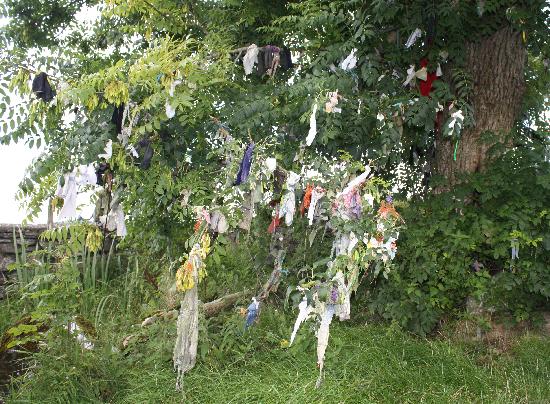Britain’s Lost Bogies: Holden Rag April 22, 2016
Author: Beach Combing | in : Modern , trackback
Holden is a stretch of countryside just to the north of Burnley, a small town in a small county (Lancashire) in the UK. It would be good to give a map at this point but Beach has decided against this because the nineteenth-century ordinance survey has this territory on an edge between map sheets. That fact will not surprise when you learn more about Holden Rag.
Holden Rag was a Lancashire bogey, one of about ten recorded from the Burnley area. But the Rag was not just your average, sorrowful ball of fur rolling around in the gloom, or a ghost dragging a chain and moaning about unpaid debts. He was, say it quietly, ‘a rag’. In the evening he would light on a bush in the Holden area and just hang there. Then, if someone was foolish enough to come and remove him from the bush, he would disappear in a flash of light…
This might strike you as eccentric behavior. But the Rag also sometimes behaved as a normal bogey should. He was seen, from time to time, in the form a black dog: Beach likes to think of these as the Rag’s offdays. As to his activities it was all the normal stuff. He blighted crops, chased gamblers, hung out with the local witches and once visited Cairo. (Really!)
But sic-transit-gloria-mundi time. He finally irritated the wrong folk: landowners or the unions, delete as your politics require. He, then, got buried beneath a big stone by a vindictive Catholic priest. The Rag will be released only when water stops running down from the Burnley hills, which will take a lot of global warming. But when he is out we are all toast…
As to Beach’s analysis…. Well, what inspired the good folk of Burnley to come up with a piece of textile as their lived nightmare? This was a weaving area, but still… Perhaps the Burnleyites were recalling the old legends about bogeys appearing as bales of wool and rolling around the valley roads and between the legs of horses, laming them.
Or perhaps what we have here is the ultimate mid nineteenth-century Lancashire boggart: baroque, unique, protean and scary as hell. Now imagine you are crossing the field when you see the strangely elongated bit of cloth hanging down from the tree. Your hand reaches out as your heart withers within you…
Any other thoughts on Holden Rag: drbeachcombing At yahoo DOT com
Note that one site has this explanation for the phrase ‘to take the rag off the bush’ (?!): surely this can’t be connected?
I have found two popular meanings, or I should say ways the expression is used. Nothing is every simple.
From Word Detective:
To “take the rag off the bush” means “to excel, to be the best or most triumphantly successful.”
This meaning appears to date back to the early 19th century when it was common to hold impromptu shooting contests. The targets were mere rags hung on bushes. The best shot would hit the rag and quite literally take the rag off the bush. Triumphant success; end of competition.
Used in an ironic sense, it means “to be breathtakingly outrageous” or, in the current vernacular, “to take the cake” (“You do take the rag off the bush, boy,” R. Coover, 1977).
Really? “To take the rag off the bush” means “to take the cake.” What does taking the cake have to do with being outrageous? Isn’t that like answering a question with a question? I need more coffee!
FromUrban Dictionary.com: Take the rag off the bush
This is an old country expression which denotes something outrageous, going above and beyond the ordinary—surpasses everything.CathyC. Hall wrote:
My mom (who’s from Savannah, GA) has said it all her life, and now I say it. Like when something really annoys me, say the library closes early because it’s so hot (which it did!), I’ll fuss and fume, saying, “Man, that really takes the rag off the bush!”
There are also apparently rag trees in Ireland…
Finally, and only 80% joking, Beach once passed a tree with a plastic bag caught in it in northern Spain, which blowing in the wind seemed archetypal.
Chris, 30 April 2016, from Haunted Ohio Books Loving these textile boggarts! Given the centrality of wool and weaving in the British economy, it seems as though the industry must have created some kind of subtext for the many textile bogeys. I suppose it is a mere step from a rag to sheeted panic-inducing ghost-impersonators. And speaking of sheets: from early times it was common practice to spread linen on bushes and in fields to bleach. Unless the location was a known votive “rag tree,” no one would think there was anything abnormal about fabric on a bush. At best they might find they could snag a free shirt or shift. At worst, an encounter with the Holden Rag.


